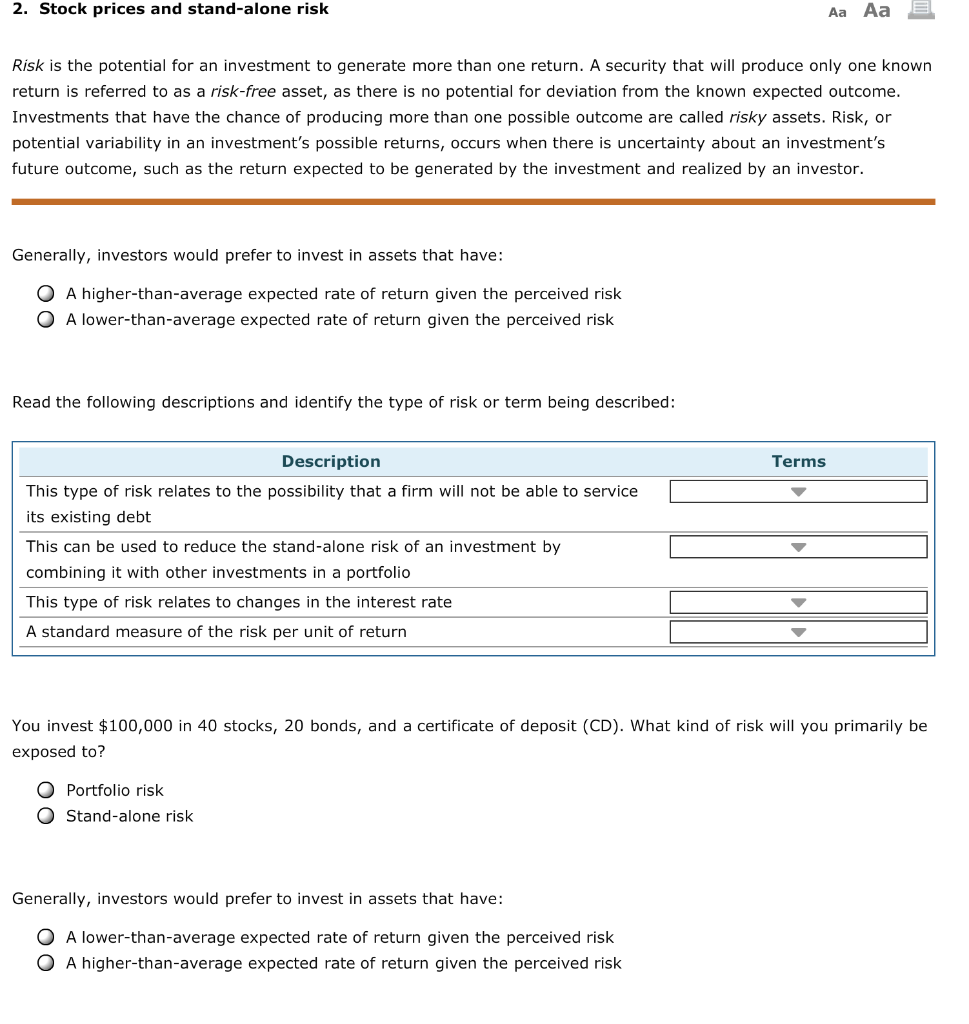Stock prices and stand-alone risk Risk is the potential for an investment to generate more than one return. A security that will produce only one known return is referred to as a risk-free asset, as there is no potential for deviation from the known expected outcome. Investments that have the chance of producing more than one possible outcome are called risky assets. Risk, or potential variability in an investment's possible returns, occurs when there is uncertainty about an investment's future outcome, such as the return expected to be generated by the investment and realized by an investor. Generally, investors would prefer to invest in assets that have: A higher-than-average expected rate of return given the perceived risk A lower-than-average expected rate of return given the perceived risk Read the following descriptions and identify the type of risk or term being described: Description This type of risk relates to the possibility that a firm will not be able to service its existing debt This can be used to reduce the stand-alone risk of an investment by combining it with other investments in a portfolio This type of risk relates to changes in the interest rate A standard measure of the risk per unit of return Aa Aa Portfolio risk Stand-alone risk Terms You invest $100,000 in 40 stocks, 20 bonds, and a certificate of deposit (CD). What kind of risk will you primarily be exposed to?
Stock prices and stand-alone risk Risk is the potential for an investment to generate more than one return. A security that will produce only one known return is referred to as a risk-free asset, as there is no potential for deviation from the known expected outcome. Investments that have the chance of producing more than one possible outcome are called risky assets. Risk, or potential variability in an investment's possible returns, occurs when there is uncertainty about an investment's future outcome, such as the return expected to be generated by the investment and realized by an investor. Generally, investors would prefer to invest in assets that have: A higher-than-average expected rate of return given the perceived risk A lower-than-average expected rate of return given the perceived risk Read the following descriptions and identify the type of risk or term being described: Description This type of risk relates to the possibility that a firm will not be able to service its existing debt This can be used to reduce the stand-alone risk of an investment by combining it with other investments in a portfolio This type of risk relates to changes in the interest rate A standard measure of the risk per unit of return Aa Aa Portfolio risk Stand-alone risk Terms You invest $100,000 in 40 stocks, 20 bonds, and a certificate of deposit (CD). What kind of risk will you primarily be exposed to?
Intermediate Financial Management (MindTap Course List)
13th Edition
ISBN:9781337395083
Author:Eugene F. Brigham, Phillip R. Daves
Publisher:Eugene F. Brigham, Phillip R. Daves
Chapter3: Risk And Return: Part Ii
Section: Chapter Questions
Problem 3MC: You have been hired at the investment firm of Bowers & Noon. One of its clients doesn’t understand...
Related questions
Question

Transcribed Image Text:2. Stock prices and stand-alone risk
Risk is the potential for an investment to generate more than one return. A security that will produce only one known
return is referred to as a risk-free asset, as there is no potential for deviation from the known expected outcome.
Investments that have the chance of producing more than one possible outcome are called risky assets. Risk, or
potential variability in an investment's possible returns, occurs when there is uncertainty about an investment's
future outcome, such as the return expected to be generated by the investment and realized by an investor.
Generally, investors would prefer to invest in assets that have:
O A higher-than-average expected rate of return given the perceived risk
O A lower-than-average expected rate of return given the perceived risk
Read the following descriptions and identify the type of risk or term being described:
Description
This type of risk relates to the possibility that a firm will not be able to service
its existing debt
This can be used to reduce the stand-alone risk of an investment by
combining it with other investments in a portfolio
This type of risk relates to changes in the interest rate
A standard measure of the risk per unit of return
Aa Aa
O Portfolio risk
O Stand-alone risk
You invest $100,000 in 40 stocks, 20 bonds, and a certificate of deposit (CD). What kind of risk will you primarily be
exposed to?
Generally, investors would prefer to invest in assets that have:
O A lower-than-average expected rate of return given the perceived risk
O A higher-than-average expected rate of return given the perceived risk
Terms
Expert Solution
This question has been solved!
Explore an expertly crafted, step-by-step solution for a thorough understanding of key concepts.
This is a popular solution!
Trending now
This is a popular solution!
Step by step
Solved in 5 steps

Knowledge Booster
Learn more about
Need a deep-dive on the concept behind this application? Look no further. Learn more about this topic, finance and related others by exploring similar questions and additional content below.Recommended textbooks for you

Intermediate Financial Management (MindTap Course…
Finance
ISBN:
9781337395083
Author:
Eugene F. Brigham, Phillip R. Daves
Publisher:
Cengage Learning


Intermediate Financial Management (MindTap Course…
Finance
ISBN:
9781337395083
Author:
Eugene F. Brigham, Phillip R. Daves
Publisher:
Cengage Learning
